May 27 - June 2, 2012: Issue 60
_________________________________________________________
An exhilarating morning was spent with the delightful people of the Bei Loon (Dragon Boat) Club and the Pittwater Pinks at Bayview on Sunday 25th of May 2012. Ensconced in the back of one of these long slim crafts was the best place to catch some of the technique involved and get some great pictures. The practice session went from Bayview to McCarr's creek for a lovely morning tea provided by the Pittwater Pinks (an annual thank-you) and back; a distance of 12km. Bei Loon Club Profile
A standard Dragon Boat team consists of 20 paddlers, a sweep and a drummer. The Drummer: The pulsation of the drum beats produced by the drummer may be considered the "heartbeat" of the dragon boat. The drummer leads the paddlers throughout a race using the rhythmic drum beat to indicate the frequency and synchronicity of all the paddlers' strokes (that is, the cadence, picking up or accelerating the pace, slowing the rate, etc.) The drummer may issue commands to the crew through a combination of hand signals and voice calls, and also generally exhorts the crew to perform at their peak. A drummer is mandatory during racing events, but if he or she is not present during training, it is typical for the sweep to direct the crew.
History
Similar to outrigger canoe (va'a) racing but unlike competitive rowing and canoe racing, dragon boating has a rich fabric of ancient ceremonial, ritualistic and religious traditions. In other words, the modern competitive aspect is but one small part of this complex of water craftsmanship. The use of dragon boats for racing and dragons are believed by scholars, sinologists and anthropologists - for example George Worcester, authoritative author of 'Junks and Sampans of the Yangtze River' - to have originated in southern central China more than 2,500 years ago, in Dongting Lake and along the banks of such iconic rivers as the Chang Jiang, also known as Yangtze (that is, during the same era when the games of ancient Greece were being established at Olympia). Dragon boat racing as the basis for annual water rituals and festival celebrations, and for the traditional veneration of the Asian dragon water deity, has been practiced continuously since this period. The celebration is an important part of ancient agricultural Chinese society, celebrating the summer rice planting. Dragon boat racing activity historically was situated in the Chinese sub-continent's southern-central "rice bowl": where there were rice paddies, so were there dragon boats.
The other main legend concerns the poignant saga of a Chinese court official named Qu Yuan, also phoneticised Ch'u Yuen. It is said that he lived in the pre-imperial Warring States period (475-221 BC). During this time the area today known as central China was divided into seven main states or kingdoms battling among themselves for supremacy with unprecedented heights of military intrigue. This was at the conclusion of the Zhou (Chou) Dynasty, which is regarded as China's classical age during which Confucius (Kongfuzi) lived. Qu Yuan is popularly regarded as a minister in one of the Warring State governments, the southern state of Chu (present day Hunan and Hubei provinces), a champion of political loyalty and integrity, and eager to maintain the Chu state's autonomy and hegemony. In the year 278 B.C., upon learning of the upcoming devastation of his state from invasion by a neighbouring Warring State (Qin in particular), Qu is said to have waded into the Miluo river which drains into Dongting Hu (lake) in today's Hunan Province—near the provincial capital city of Changsha and south of the city of Yueyang on Donting Hu, site of the first IDBF World Dragon Boat Championship in 1996—holding a great rock in order to commit ritual suicide as a form of protest against the corruption of the era.
The common people, upon learning of his suicide, rushed out on the water in their fishing boats to the middle of the river and tried desperatedly to save Qu Yuan. They beat drums and splashed the water with their paddles in order to keep the fish and evil spirits from his body. Later on, they scattered rice into the water to prevent him from suffering hunger. Another belief is that the people scattered rice to feed the fish, in order to prevent the fishes from devouring the poet's body.
However, late one night, the spirit of Qu Yuan appeared before his friends (that is, he resurrected from the dead) and told them that the rice meant for him was being intercepted by a huge river dragon. He asked his friends to wrap their rice into three-cornered silk packages to ward off the dragon. This has been a traditional food ever since known as zongzi or sticky rice wrapped in leaves, although they are wrapped in leaves instead of silk. In commemoration of Qu Yuan it is said, people hold dragon boat races annually on the day of his death.
Dragon boat Drummer and History. (2012, May 24). In Wikipedia, The Free Encyclopedia. Retrieved from http://en.wikipedia.org/w/index.php?title=Dragon_boat&oldid=494088089
Carrying to Water: dragon boats for 20 can weigh 500 pounds and require all hands to lift and carry to water
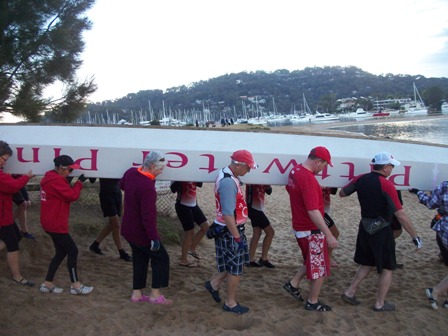
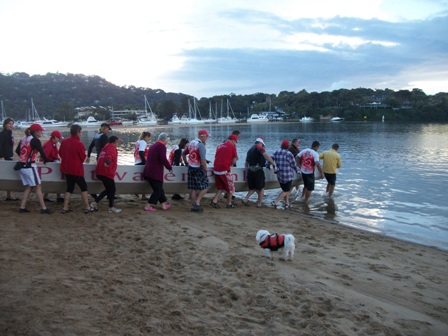
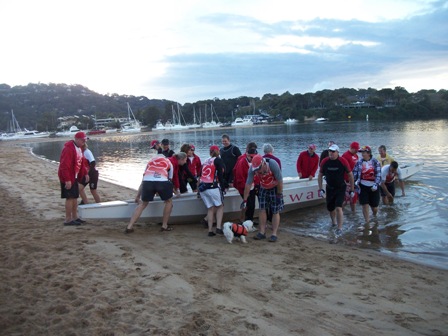
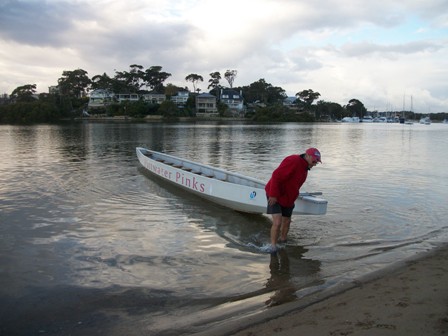
Next:
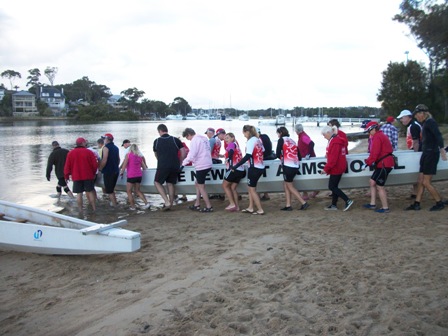
Warming up and Stretching
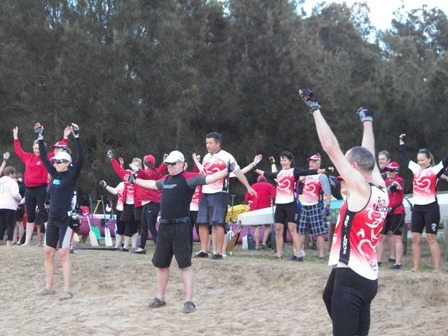
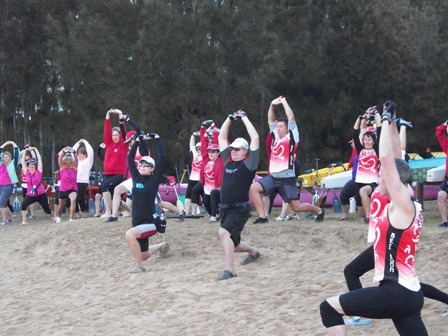
The Sweep keeps the boat straight; required when racing in competitions where each boat has a lane. This shows the straight line of the Pittwater Pinks boat when entering Coal and Candle Creek last Sunday, 20th of May
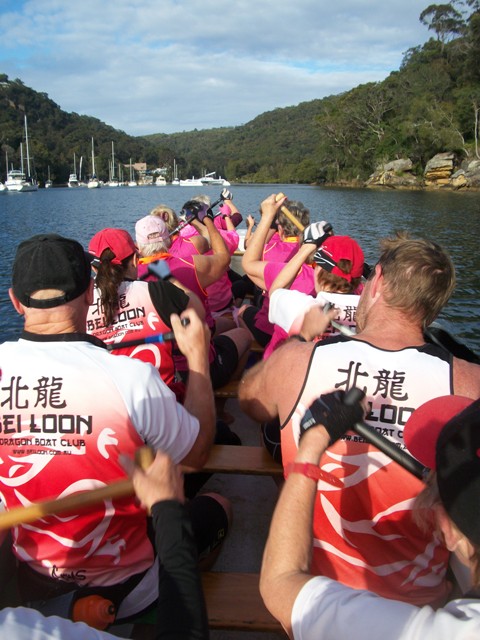
Coming in to Dock/Beach and Disembark:
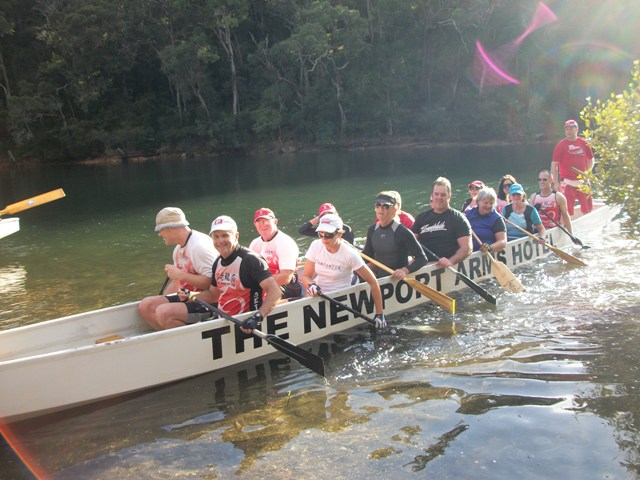
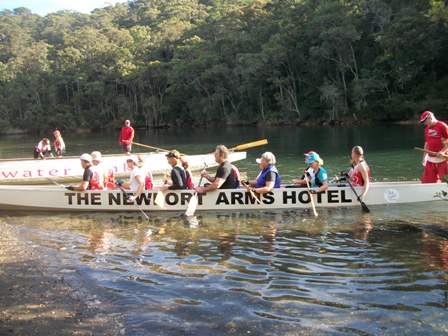
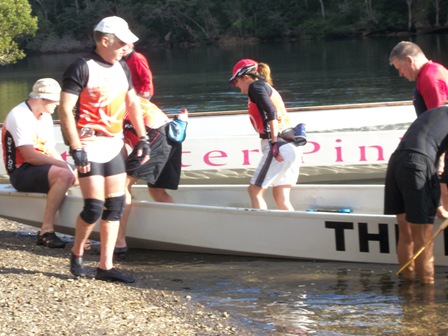
Mascot: Bundy who will add an extra 'Woof' but only when Glenn yells 'go!' not when anyone states this start remark. In his lifejacket, with handle, owned by Robyn (sweep) & Greame Sheather (Champion), Great Grand Masters
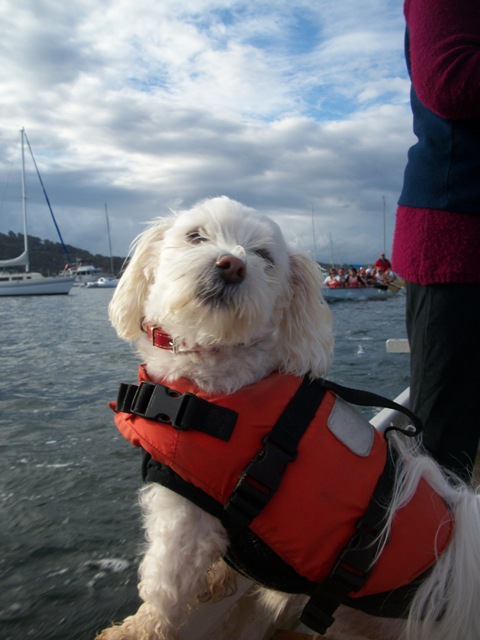
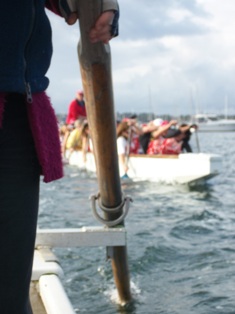
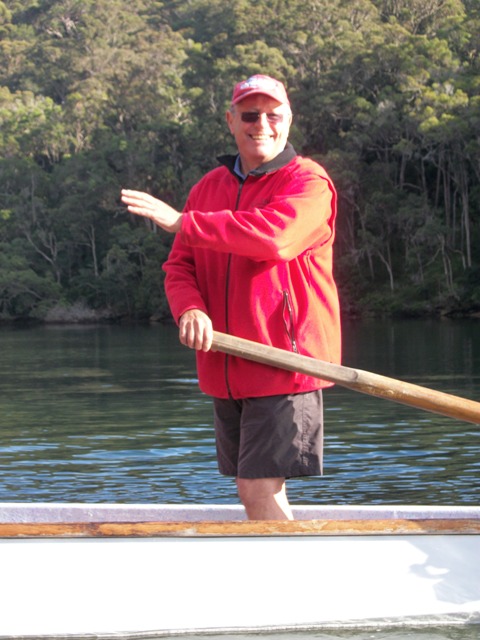
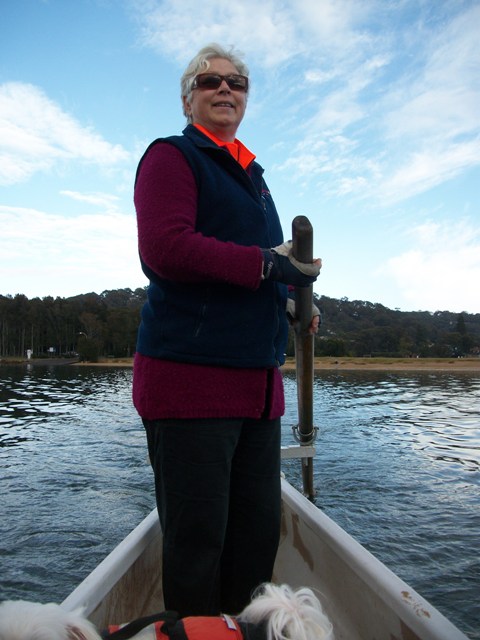
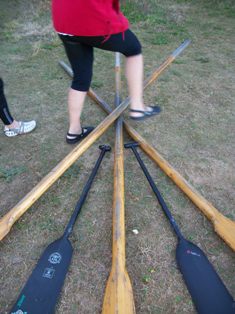 Paddles and Oars: The paddle now accepted by the world racing federation has a standardised, fixed blade surface area and distinctive shape derived from the paddle shapes characteristic of the Zhu Jiang (Pearl River) delta region of Guangdong Province, China, close to where Hong Kong is situated. The PS202 pattern blade has straight flared edges and circular arced shoulders based geometrically on an equilateral triangle shape positioned between the blade face and the neck of the shaft.
Paddles and Oars: The paddle now accepted by the world racing federation has a standardised, fixed blade surface area and distinctive shape derived from the paddle shapes characteristic of the Zhu Jiang (Pearl River) delta region of Guangdong Province, China, close to where Hong Kong is situated. The PS202 pattern blade has straight flared edges and circular arced shoulders based geometrically on an equilateral triangle shape positioned between the blade face and the neck of the shaft.
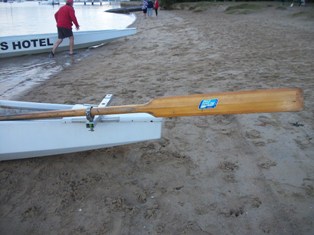 The sweep, known also as the steersman controls the dragon boat with a sweep oar rigged at the rear of the boat, generally on the side and off centre, which is used both for ruddering as well as for sweeping the stern sidewards. The word "starboard" is Scandinavian in origin and refers to the wooden board for steer(ing), that is, the sweep oar.
The sweep, known also as the steersman controls the dragon boat with a sweep oar rigged at the rear of the boat, generally on the side and off centre, which is used both for ruddering as well as for sweeping the stern sidewards. The word "starboard" is Scandinavian in origin and refers to the wooden board for steer(ing), that is, the sweep oar.
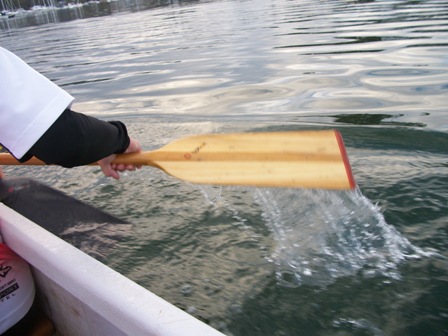
Paddling: Glenn Smyth, originator of the Bei Loon Club, kept emphasising on Sunday that Base Training is the Basis of everything you do while reiterating the different strokes and methods for paddlers. Each paddler has a Timing Partner, the person next to them or the paddlers in the front of the boat. There are long strokes, float strokes, and as you paddle on one side of the body and must have some balance, there is also Changeover, sometimes 'on the run' (whilst boat is still in motion) where beginning at the front of the boat, paddlers swap sides carefully so the other arm is used. Changeover works its way to the back until all paddlers have changed. Some remarked that they find the arm they use to write with etc. seems to be their strongest.
Dragon boat stroke cycle:
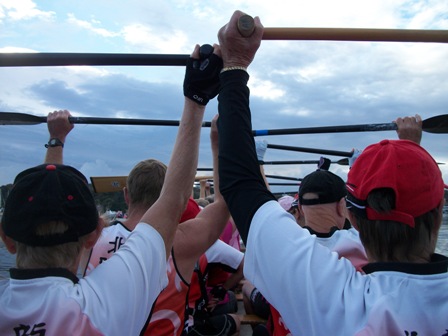
1. Paddles above head waiting for Sweep or Drummer (during competitions) or Race runners start signal.
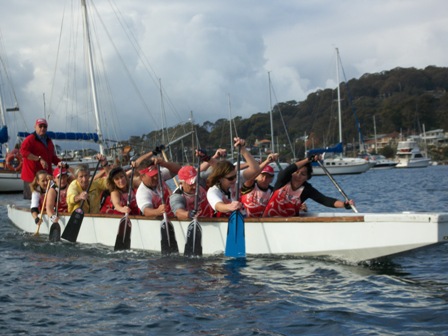
2. The "reach and catch" begins the cycle
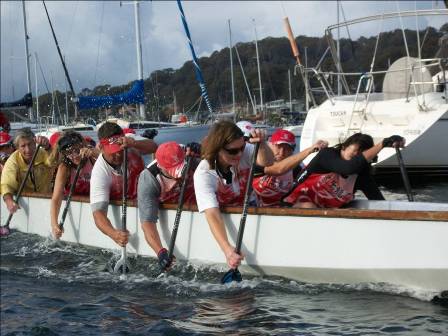
3. The powerful "pull" stage sustains the forward momentum of the boat; the paddle is pulled backwards.
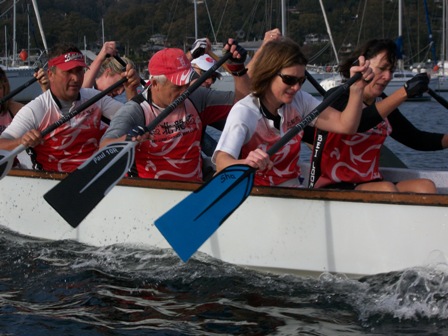
4. The "release" in which the blade is instantaneously drawn (skywards) while it is even with the hips of the paddler
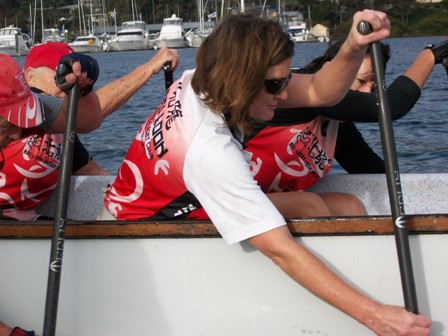
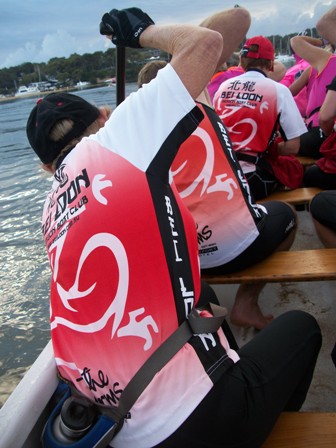
5. The "recovery" is the final stage of the stroke and consists of the rotation of the torso with the forward repositioning of the blade thrust forward into the optimal catch.
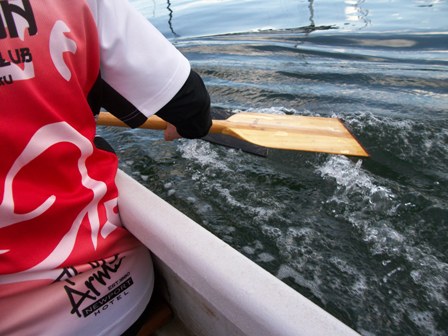
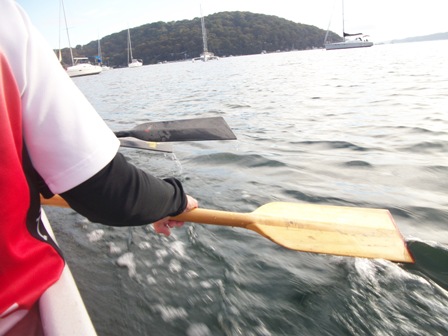
Floating: paddles lifted out or laid flat on water surface for rest from paddling, slowing craft to a smooth glide to do a changeover or when coming into dock/beach
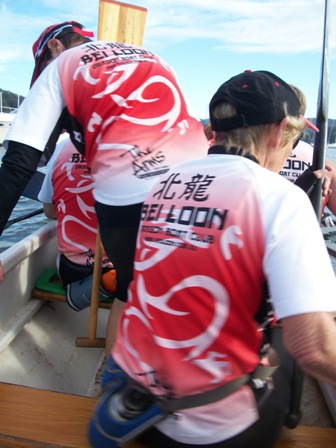
Changeover; either 'on the run' or when 'floating' with paddles flat so craft is moving forward or stilling
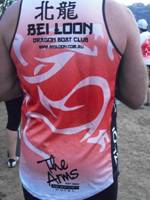 All Images by A J Guesdon, 2012
All Images by A J Guesdon, 2012


Top: everybody that was there from Bei Loon Dragon Boat Club, Sunday May 25th, 2012. Above: The Pittwater Pinks girls with Glenn Smyth.


Above: spot the legends. Below: Landing again at Rowland Reserve, Bayview and putting the boats away; team effort.


